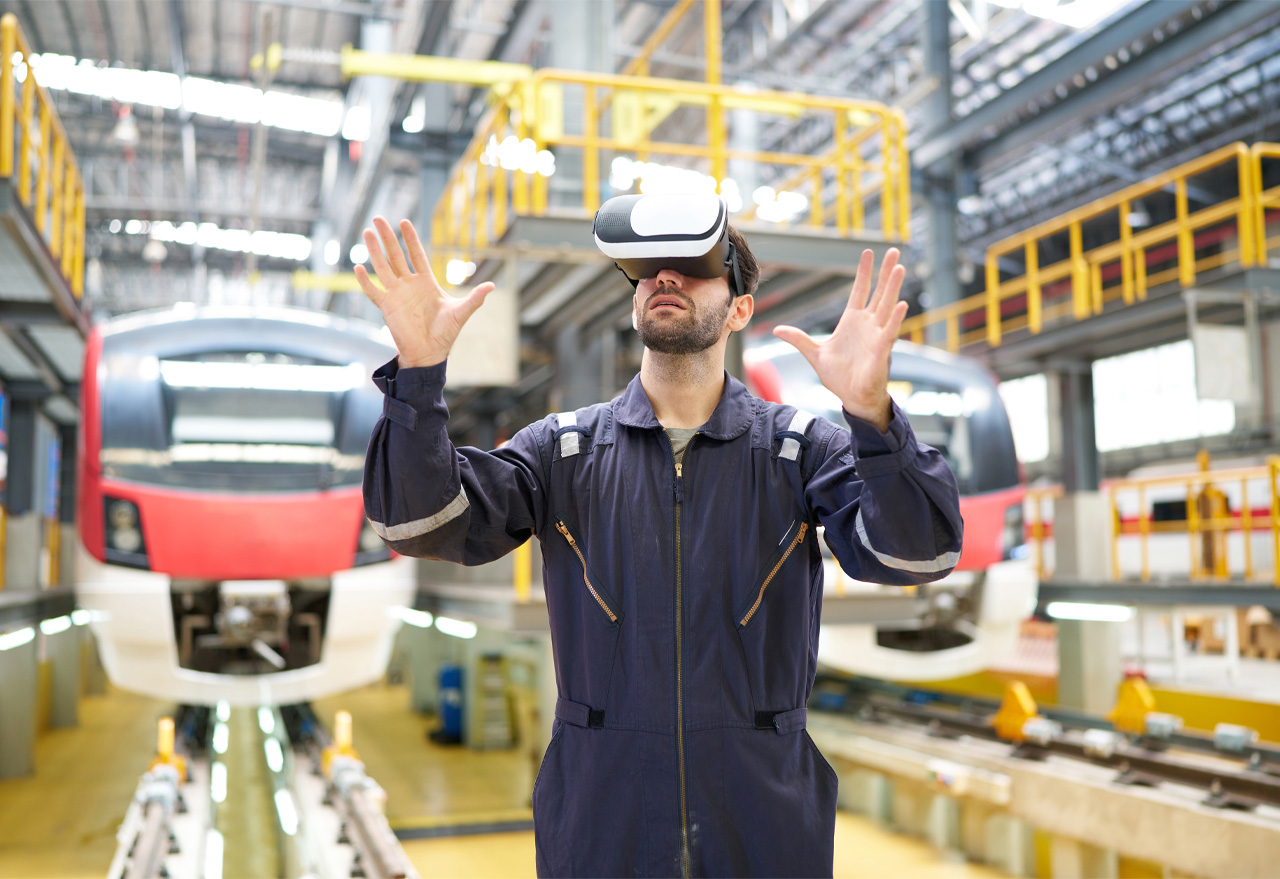The railway sector is moving full steam ahead into the digital age, and the recent Rail Forum Annual Conference made that clear.
A more digitally focused future includes organisations starting to realise the value of Extended Reality (XR) – a catch-all term for Virtual Reality (VR), Augmented Reality (AR) and Mixed Reality (MR).
While these technologies aren’t exactly new – AR, for example, was first used by the military in 1956 – the advancements in both software and hardware are accelerating their potential. But where exactly can XR be applied in the rail industry?
Fresh from attending the conference, Commercial Director, Harvey Trent, touches on the specific ways XR can solve some of the toughest challenges – performance, efficiency and safety.
Streamlining Operations with XR
The rail industry operates at an incredible scale, managing vast networks of trains, stations, and tracks. Efficiency is a non-negotiable. XR technologies are providing innovative ways to streamline operations and improve reliability.
Workforce Training and Onboarding
Training in the rail industry has always come with a certain level of risk. How do you prepare employees for complex train operations without putting them in harm’s way? Both AR and VR solve this problem. Picture being able to step into a virtual world where both new and existing employees can practice everything from operating trains to repairing faulty infrastructure. These virtual environments allow employees to engage with high-risk scenarios without consequences, preparing them for the real thing. The best part? They can practice over and over again, improving their skills each time.
Predictive Maintenance
In the rail world, breakdowns and delays are costly. They disrupt schedules, affect passengers, and can put a serious dent in the bottom line. AR is shifting the focus from reactive to proactive. With AR devices, maintenance teams can access real-time data right in their line of sight. This means spotting issues early, before they turn into major problems. Whether it's wear and tear on tracks or malfunctioning parts on a train, AR helps technicians make quicker, more informed decisions. The result? Less downtime, fewer delays, and a smoother journey for everyone.
Optimising Logistics and Network Management
The logistics of running a train network are staggering. Coordinating thousands of trains, tracks, and schedules requires precision and real-time adjustments. XR brings clarity to this complex web by offering real-time visualisations of the network. Operators can see train locations, track conditions, and even weather forecasts, all at a glance. When disruptions occur – whether from bad weather, technical failures, or traffic – XR provides the tools to adjust quickly and effectively. It's about staying ahead of the game, keeping trains on track and passengers happy.
Putting Safety First with XR
The stakes are high in rail with so many moving parts, and every precaution counts towards keeping people safe. XR technologies are enhancing safety in ways that weren’t possible before.
Emergency Response Training
Preparation is everything when it comes to emergencies. Minutes matter. VR allows rail employees to rehearse emergency scenarios repeatedly – without the risk of injury or disaster. Whether it’s a train derailment, a fire on board, or an accident at a station, staff can practice and refine their responses. The immersive nature of VR also helps employees internalise emergency protocols, ensuring they stay calm and effective.
Real-Time Hazard Detection
On the ground, safety is all about awareness. Maintenance crews, station staff, and train operators can use AR to stay alert to hazards in real-time. Overlaying important data directly onto the user’s field of vision helps workers make quicker, safer decisions. Imagine a technician using AR glasses that display a track’s current condition while they’re inspecting it, allowing them to catch potential issues before they become serious problems.
Remote Assistance
Sometimes, the best way to solve a problem is with a little help from a remote expert. Wearable devices with AR capabilities enable real-time, virtual collaboration between on-site workers and experts who are miles away. Using the camera, experts can see exactly what the worker is seeing and guide them through the necessary steps. Whether it’s troubleshooting a technical issue or providing on-the-spot emergency assistance, AR ensures that help is always available. This not only speeds up problem-solving but also reduces the need for on-site experts to travel, improving both efficiency and response time.
Enhancing the Passenger Experience with XR
The railway industry isn’t just about keeping trains running. It’s about making sure passengers have a positive, stress-free experience from start to finish. XR is playing a key role in transforming the passenger journey, making it smoother and more enjoyable.
Station Navigation
Navigating a busy train station can be a challenge – especially in large, complex terminals. But AR is changing the way passengers find their way around. With AR apps or wearable devices, passengers can access real-time directions to their platform, nearby amenities, and even points of interest within the station. No more confusing signs or last-minute platform changes.
The Track Ahead: XR and the Future of Rail
The potential for XR in rail is just beginning to be realised, and the path looks incredibly promising. As the industry embraces these technologies, rail companies are poised to reap the benefits of more efficient operations, safer practices, and satisfied passengers.
For companies that are ready to take the next step, the time to embrace XR is now. The tracks are laid – now it’s time to move full speed ahead.





